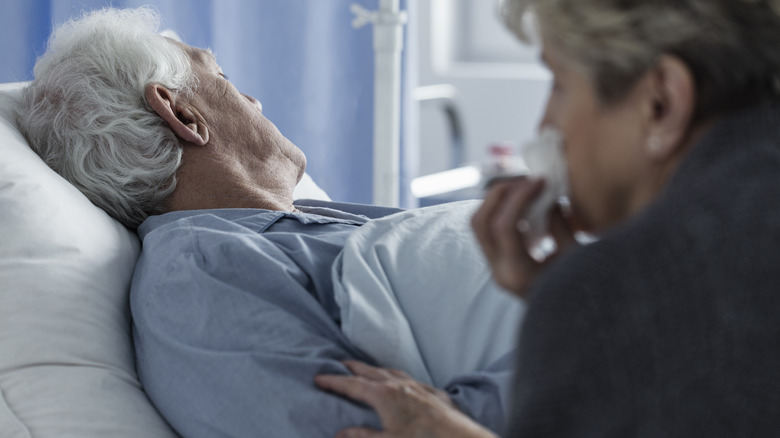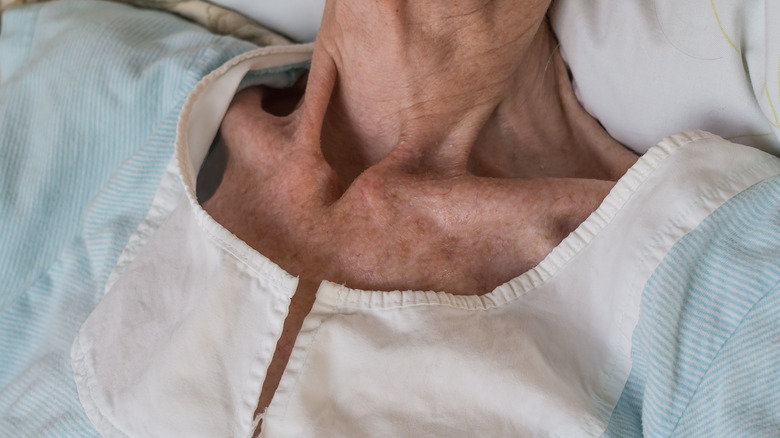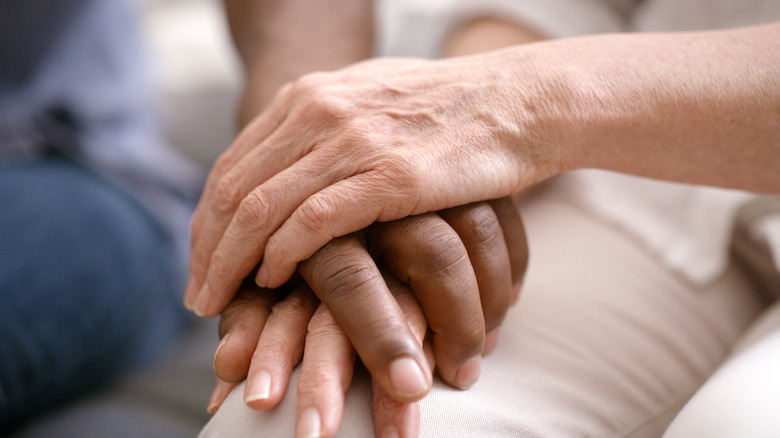The Strange Thing Someone's Neck Might Do A Few Days Before Death
A person's body and mind go through quite a few changes when they are close to death. Cold skin (from reduced blood flow to the area), a decreased appetite, changes in breathing, losing control of your bladder and bowels, and even agitation are all warning signs that mean a person is nearing death. Some people might even see ghosts before death, which, according to experts, is not entirely uncommon. Those who study the phenomenon link it to changes in brain-level electrical activity, while others might be inclined to think that this is proof of life beyond this plain.
Near-death visions aside, a 2015 study published in the journal Cancer looked for physical signs every 12 hours from admission to death or discharge in 357 cancer patients admitted to acute palliative care, all of whom were in their final days of life. The researchers found that something strange happens to a person's neck when they are close to dying: their neck hyperextends.
Your neck is supported by a musculoskeletal system, complete with bones, tendons, and ligaments, that allow you to hold your head up, move your neck from side to side, and look up and down. In the very final moments before death (three days before, to be specific), the patient's head tilts back when in a supine position, per researchers. But why does this occur, exactly?
Neck hyperextension and death: How are they related?
In a healthy person who isn't close to dying, hypertension of the neck might commonly be referred to as whiplash. A car accident, injury, or any other sudden force on your neck could result in hypertension of your neck.
The 2015 research, led by Dr. David Hui of the MD Anderson Cancer Center, didn't go into detail about why this particular physical sign comes about in someone who's close to dying. Reduced blood flow to your musculoskeletal system brought on by your body trying to primarily keep central organs alive, combined with reduced muscle mass and loss of weight (other signs of impending death), can lead to your neck tilting back. Newborn babies aren't able to support their heads because their muscles aren't strong enough. Perhaps, when we're nearing death, some of those muscles and other supporting structures lose their strength once more. Plus, a person's facial muscles are known to relax when their time is nearing. This could be connected to the neck hypertension phenomenon, too.
Another possible explanation could be specifically related to cancer. Since the study looked at cancer patients in particular, it could be that muscle wastage brought on by declining protein synthesis leads to a person's neck going limp close to death. There is a term for this in cancer lingo: cachexia. Science refers to it as an unexplained muscle mass wastage and weight loss that comes with advanced stages of cancer.
Are there other physical signs that accompany a tilting of the neck?
The study in question actually uncovered seven more physical signs in the patients, 57% of whom died during the study. The other signs that you might see include non-reactive pupils, reduced response to verbal stimulants, decreased response to visual stimuli, inability to close eyelids, drooping of the nasolabial fold (the skin on both sides of your nose that extends from your nose to your mouth), grunting of vocal cords, and upper gastrointestinal bleeding.
According to Dr. David Hui (via Ecancer), uncovering such physical signs can help caregivers and health professionals provide the best possible care to dying patients. By alerting those around them that these are warning signs of the final moments before death, care can focus on improving comfort for the person who's dying, instead of actively trying to prolong their life.
Dying and death are never comfortable topics to discuss. However, this doesn't mean we won't ever have to face the reality with a loved one (or ourselves). Knowing about the different physiological changes that come with the process could help you focus on the most important things before it's time to say goodbye, like bringing family and friends together to pay their respects. It might give you space to spend the little time you have with your loved one meaningfully.



